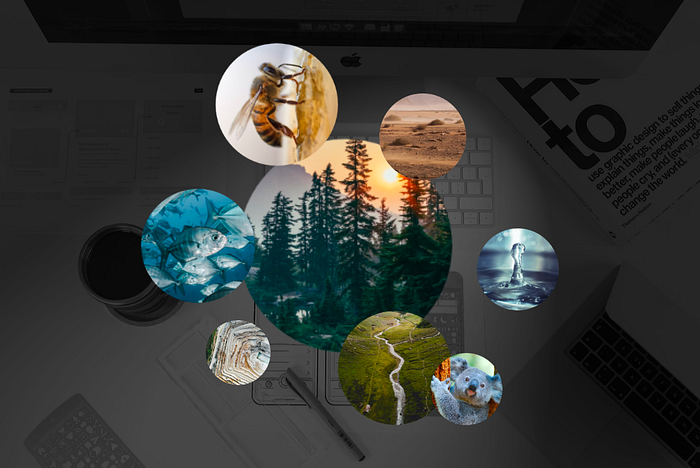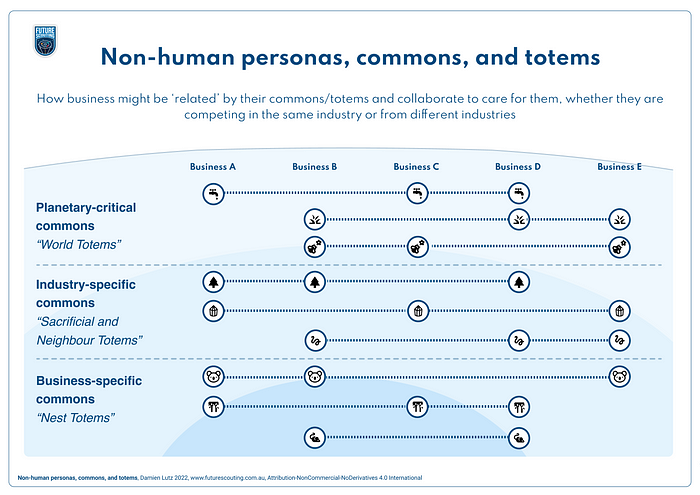Non-human personas and totems
Should industries create non-human personas for their collective resources, and be guided by the traditional wisdom of totemism, to deepen the relationships between humans and the world?

Over the last few years, experimentation with aligning modern design with sustainability, regeneration, and inclusion has grown.
One strategy is to identify the needs of non-human using non-human personas — personas representing natural environments and animals — for designers and businesses to consider as well as human users.
Non-human personas may represent animals and ecosystems impacted by our products, businesses, and behaviours, but they can also be the resources we use to create our tools and goods.
In a way, non-human personas are related to two existing concepts connecting humans to animals and nature:
- Commons—The ‘commons’ refers to a community/collective’s shared natural, cultural, and digital resources
- Totemism—The traditional, First Nations wisdom concept of ‘totems’ that nurtures deep relationships between humans and animals and nature
Could these concepts merge to deepen the developing world’s take-make-waste relationship with nature to make the design of anything more regenerative and fair?
This speculation explores how the concept of commons could be used to connect businesses using the same resources by collectively creating non-human personas as shared knowledge, and then deepening the relationship between humans and non-humans with the traditional wisdom of totemism.
What are non-human personas?
Non-human personas are a recent evolution in modern design of the traditional human persona concept which categorise and summarise customer types based on various aspects such as needs, demographics, life stage, etc.

Non-human personas represent the natural resources, environments, and ecosystems used and/or impacted by a product/business. These personas can then be used whenever human personas are used to ensure that non-human needs are considered in design decisions.
But there are challenges to using non-human personas, including:
- If the data used to create a non-human persona isn’t accurate, design decisions based on that data could have unintended and/or negative impacts on the non-human or others
- The time needed to accurately create non-human personas can be a hindrance to their use, particularly in fast-paced, profit-focused projects (the majority of modern design!)
What are the commons?
The ‘commons’ refer to a cultural, natural, or digital resource accessible to all members of a society or community, that is collectively managed to protect the resources and ensure they are sustainable and regenerated. ‘Commoning’ refers to the people coming together to manage these resources, which also deepens relationships in the community.
Commons may be held in protection, or used and managed for collective and sustainable benefit by a ‘community of users that self-governs the resource through institutions that it creates’.
Sustainable practices are not new, of course — First Nations peoples have been practicing sustainable lifestyles and living in harmony with nature for tens of thousands of years.
Discussion about merging modern design with traditional wisdoms has also grown, but I’ve often wondered how exactly we do that.
So, I considered what First Nations wisdom could inform how modern design uses non-human personas, and I recalled the concept of totems.
What are totems?
The totem information in this article was sourced from information written by First Nations peoples.
Totems represent non-human entities like natural objects, plants, animals, spirit beings, or the weather.
The word totem is actually an anglicisation of the Ojibwe word for clan (doodem).
Different cultures use different terms, for example:
- Auguds, from Torres Strait Islanders
- Jadiny, from Indigenous Australians
How totems are identified (and how many), how they are connected to a person or group, and how they are used, all differ between cultures, and even between groups within cultures.
In Indigenous Australian totemism, people belonging to the Emu as a totem are held accountable for what happens to the Emu and they must learn and teach others about Emu needs.
Examples of relationships with totems:
- As guides and lesson teachers
- To represent certain attributes or values for personal growth — For example, in Indigenous North American totemism, an alligator represents stealth and a fight for survival, while the ant represents teamwork and overall perseverance
- To identify the different responsibilities of each clan
- To represent non-human beings to be respected, nurtured, protected, and knowledge about them shared and preserved
Examples of how totems are gained:
- Chosen by an Elder, family member, or the mother, and given at a young age or Coming of Age Ceremony
- Chosen by the individual, which can be therapeutic and spiritual or a more practical choice for personal growth
- The totem ‘chooses the person’, via ceremony or identified in key moments in one’s life
Examples of the number of totems per person/clan:
- In Indigenous Australian totemism, each person has at least four totems, one each for the nation, clan, family, and an individual totem
- The Ojibwe peoples use one totem per clan
While there are many variations of totemism, there is also a common underlying purpose, which is to consider the world beyond humans—and to consider these things not just as resources but as lifeforms to be respected—by forming relationships and a sense of responsibility between humans and the natural world—which correlates with the purpose of non-human personas.
So how might we evolve the use of non-human personas in the design and business world by learning from the traditional and ecological wisdom of totemism and commons?
Determining the commons of a product or business as a totem
Products and businesses could determine their totems according to their common resources by taking inspiration from how totems are traditionally determined:
- ‘By family member’ — This could correlate to the industry a product/business belongs to (Industry Totems). For example, any printer of paper goods could automatically gain a ‘Trees and Forests’ totem. Any business selling personal devices could automatically gain ‘Rare earth metals’ as totems. A benefit of this would be that as these totems would be used by so many, their personas could be made once and managed by experts in the industry (scientific and traditional), meaning individual groups, organisations, and businesses wouldn’t need to speed the time creating the personas on their own, and there would be less risk of inaccuracy and more sharing of strategies.
- ‘By individual’ — Each individual product or business could also gain totems to represent any non-humans their specific business impacts beyond the industry commons (let’s call them Nest Totems for now)
Perhaps also the Industry totems could be defined by two types of relationships, those directly sacrificed as resources (Sacrificial Totems), and those that are ecosystems impacted by the business/industry (Neighbour Totems). The Neighbour Totems might represent specific areas where the Sacrificial Totems are taken from or some other ecosystem impacted along the product lifecycle.
Thinking globally, and taking inspiration from modern science, perhaps all businesses would gain at least one global totem to represent non-humans in urgent dire danger worldwide (World Totems). They might be based on the most urgent planetary boundaries as defined by science, and by traditional wisdom.
Using words like ‘Sacrificial’, ‘Neighbour’, ‘Nest’, and ‘World’ rather than ‘resource’, ‘ecosystem’, and ‘global’ might connect us more deeply to the lifeforms we are taking from and/or damaging.

An example
As an example subject, let’s use a website that sells digital and paperback books.
Identifying totems
Based on two key industries this business belongs to (the book publishing industry and tech industry), it could automatically belong to the following Sacrificial Totems:
- Coniferous Trees & Forests (Book publishing industry)
- Rare Earth metals, Air (Digital tech industry)
And they would then automatically belong to the Neighbour Totems to represent the ecosystems impacted by the business supply chain and lifecycle. As an example:
- Village ecosystems damaged by rare earth metal mining and factories used for the technology needed for the business’ website, and the e-readers required to enjoy its books
The business might also identify Nest Totems, based on the specifics of its business, such as its locality:
- Timber plantations in NSW (if we determined the paper for the printed books came from NSW)
- Koala or other animals impacted by timber plantations
Our hypothetical business would also belong to a World Totem, such as:
- Clean water (To connect to all the water used in paper and technology production and their contribution to the worsening water scarcity)
The totems of the example small business might then look like this:

Employing non-human personas as totems
Drawing from the collective knowledge of their commons in the form of collaboratively-created non-human personas, and guided by the traditional wisdom of First Nations Peoples’ relationships with totems, businesses could use their prosperity, innovation, and influence to develop ways to:
- Replace or reduce the use of their Sacrificial Totems
- Reduce and restore the impact on their Neighbour Totems
- Enrich healthy instances of their Sacrificial and Neighbour Totems
- Learn about their totems and teach others and the public about them
- Understand the specific characteristics of their totems (strength, community, perseverance, etc.) and champion these values in themselves and in others
Creating decentralised collaboration
All businesses might then be ‘related’ by their commons/totems and collaborate to care for them, whether they are competing in the same industry or from different industries, creating networks that transcend traditional barriers of collaboration.
This incorporation of totemism into the business could create a new layer of collaboration between competing businesses, and between design teams and businesses from completely different industries.

Forming expert coalitions
Martin Tomitsch suggested the practice of forming a coalition of experts to inform the creation and use of non-human personas. While this makes perfect sense, it would often be impractical for many projects and therefore not attempted.
But if the business world integrated commons thinking and totemism, then every business with the same commons could collectively create and maintain non-human personas representing the knowledge of and relationships with their commons, forming a global coalition of experts, whose non-human persona knowledge would be available to all.
Non-human personas
What then, would non-human personas be, in terms of being accessible knowledge to ensure human industry and activity respected nature? Would they be digital twins constantly updated by the coalitions, and by data generated real-time by the non-humans? Would there be rituals to develop our relationship with the non-humans?
Using digital interpretations of non-humans risks the desensitising of the human’s side of the relationship. Perhaps they could be guided by First Nations techniques of connecting with totems to deepen the experience to be more ‘therapeutic and spiritual’.
Deepening the relationship
As the research of Martin Tomitsch and the experience of Victor Udoewa suggest, non-human personas are not just a tool, but also a method. The process of identifying and creating personas, whether human or non-human, creates the shared understanding of and relationship with the non-human.
Therefore, all those using the personas would need to be part of the process of contributing to the knowledge base and strengthening the relationship, to create their own relationship with their totems.
Connecting to original totemism
Could this adoption of totemism by the developed world also then connect to the original ways of local totemism?
Perhaps all world citizens, First Nations and beyond, could adopt totems to personally and deeply connect with the land and animals they depend on, from the products and businesses they use to the things they make and own, to the places they work in and visit.
But that could all only be really explored as a respectful discussion with First Nations peoples.
To summarise
To create a respectful relationship between human industry and nature, and to transition human industry into a more regenerative model, businesses could explore:
- Recognising and using the commons of their industry to collaborate with other businesses of the same industry to regenerate their commons
- Collectively creating and maintaining non-human persona artifacts accessible by all
- Requesting to collaborate with First Nation’s people to learn how this speculative use of totemism could deepen the relationship between human industry and nature
Accelerating the transition
Such an organised understanding of and respect for all non-humans would surely accelerate the transition of developed countries to a sustainable, regenerative, and inclusive model at a time when acceleration is most needed.
As the developed world with its human-centred design sees itself ‘evolving’ into a more life-centred iteration, with models such as the Doughnut Economy, it is really just remembering what First Nations people recognised tens of thousands of years ago — we need to respect and nurture the two most important relationships, that between people and people, and that between people and land.

Perhaps merging commons and totemism with non-human personas isn’t about evolving the use of non-human personas, but bringing them back to where they originated from — a respectful relationship with all life.
While the totem information in this artcile was sourced from information written by First Nations peoples, I would recommend respectfully engaging First Nations people before attempting to interperate and integrate their totemism commercially. There is a lot more to each culture’s relationship with totemism (example).
I would also like to use this article as an invitation to any First Nations persons who would like to explore this further collaboratively — please contact me!
Learn everything about non-human personas with the guidebook and toolkit
More from Damien…
Explore Damien’s two design innovation labs:
- Life-centred Design Lab — expanding human-centred design to include nature and invisible communities
- Future Scouting — Designing life-centred, values-driven future tech products with speculative design
Get practical with tools and courses:
- Life-centred Design Books and Toolkits
- Life-centred Design Courses
- Life-centred Design Innovation Cards
Follow Damien on Medium for more fringe design thinking and experiments.

